
Kai Normann Andersen was a Danish composer who wrote film scores and music for stage revues and dramas. He composed songs for over 50 films between 1930 and 1965. In the 1930s and 1940s he dominated Danish film music. He has been called "[o]ne of the most appealing personalities of our time in the light music field". Twelve of his songs have been included in the Danish Culture Canon. Connie Hedegaard and Claus Hagen Petersen list him among the 100 most important Danes of the 20th century.

Oluf Høst was a Danish Expressionist painter, the only member of the Bornholm school who was a native Bornholmer. Although he studied in Copenhagen, he returned to the Danish island of Bornholm in 1929 where he remained with his family for the rest of his life. Bognemark, a little farmhouse near Gudhjem, was one of Høst's favourite motifs. From 1935 on, he painted the farm some 200 times under varying conditions at different times of the year, often reflecting his particular mood at the time. His home in Gudhjem, built from two fishermen's cottages with a rocky garden in the rear, is named "Norresân" after the nearby harbour, Nørresand Havn, where he painted many of his works.
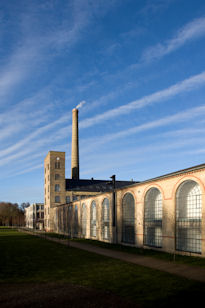
The National Museum of Denmark's new museum, Brede Works, lies in the countryside just north of Copenhagen in Denmark's largest, protected industrial plants. At the museum of Industrial culture, the visitors can be guided around by its own virtual person between old machines, hear how Denmark became an industrial society and even try to work at an assembly line. The exhibitions show the industrial development which has changed the everyday lives of the Danes over the past few centuries.

Gl. Holtegaard is a former Manor house in Rudersdal Municipality north of Copenhagen, Denmark, today operated as an arts centre and a museum. It was built by the Danish Baroque architect Lauritz de Thurah (1706–1759), for his own use in 1757. Its original Baroque gardens were reconstructed in 2003.
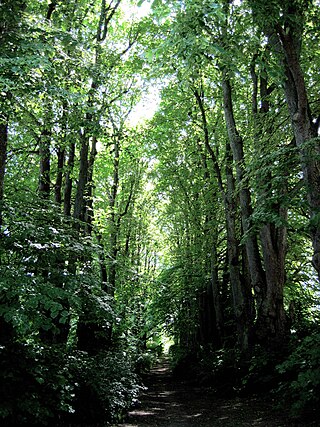
Mariebjerg Cemetery is located in Gentofte north of Copenhagen, Denmark. It was laid out between 1926 and 1933 to the design of the landscape architect Gudmund Nyeland Brandt and is considered an important example of European Modernist landscape architecture. Its design has inspired many other cemeteries both in Denmark and abroad.

Garrison Cemetery is a cemetery in Copenhagen, Denmark. It was inaugurated in 1671 on a site just outside the Eastern City Gate, as a military cemetery complementing the naval Holmens Cemetery which had been inaugurated a few years earlier on a neighbouring site. Later the cemetery was opened to civilian burials as well.

Raadvad, or Rådvad is a former industrial development located on both sides of the Mølleåen river which at this point marks the border between Lyngby-Taarbæk and Rudersdal municipalities in the northern suburbs of Copenhagen, Denmark. It was built around a watermill in the second half of the 18th century and has given name to a well-known Danish brand of knives and other kitchen equipment. The buildings are now all heritage listed. They include Raadvad Kro from 1861 and a hostel based in a former school from 1894. Other buildings include a centre for building conservation and a local nature school.
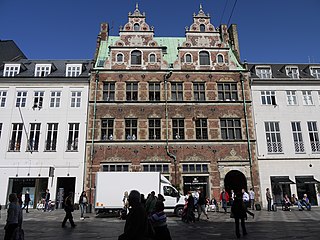
The Matthias Hansen House, formerly also known as the Schoustrup House, is a Renaissance-style townhouse on Amagertorv in central Copenhagen, Denmark. Built in 1616, it is one of few buildings of its kind which has survived the Copenhagen Fires of 1728 and 1795. The building is now home to a flagship store for the Royal Copenhagen porcelain factory.

Frederiksberg Ældre Kirkegård is a cemetery in Frederiksberg, Copenhagen. It was established in 1734 behind Frederiksberg Church.

Nyhavn 51 is an 18th-century canal house overlooking the Nyhavn canal in central Copenhagen, Denmark.Above the door is a painted stone relief depicting a lamb. The property was formerly known as Lammet and the sign was used for identification in a time when house numbers had still not been introduced. The letters are the initials of the builder Henrich Lambertsen Engel and his wife Karen Nielsdatter Holm. The building was listed in the Danish registry of protected buildings and places in 1918. It was subject to Schalburgtage during World War II but restored. Notable former residents include the portrait painter Hans Jørgen Hammer, the marine artist Carl Frederik Sørensen and Swedish actress Eva Eklund.

Helen Schou was a Danish sculptor most known for her works of horses. Her two most-known commissions are the equestrian statue of King Christian IX commissioned for the Aarhus Cathedral and the Jutland Stallion commissioned by the City of Randers. She was honored as a Knight of the Order of the Dannebrog in 1965 and elevated to a Knight 1st Class in 1974.

Kronprinsessegade 34 is a Neoclassical property overlooking Rosenborg Castle Garden in central Copenhagen, Denmark. It was listed on the Danish registry of protected buildings and places in 1945. Notable former residents include the writer Genrik Hertz and educator Athalia Schwartz.
Beauvais is a Danish brand of condiments, snacks and readymade meals now owned by Norwegian food company Orkla ASA. The brand was founded by and is named for Jean Baptiste Desiré Beauvais, a French immigrant, who established a production of canned food in Copenhagen in 1850. The company was acquired by Orkla in 1995 and renamed Orkla Foods Denmark in 2013.

Nyhavn 55 is a just three-bays-wide, 18th-century canal house overlooking the Nyhavn Canal in central Copenhagen, Denmark. The building was listed in the Danish registry of protected buildings and places in 1918. The heritage listing comprises a half-timbered perpendicular side wing on its hear.

Skindergade 44 is a Neoclassical property situated on Skindergade, off Gammeltorv, in the Old Town of Copenhagen, Denmark. It was listed in the Danish registry of protected buildings and places in 1945.

Knabrostræde 19 is a Neoclassical property situated at the corner of Knabrostræde and Kompagnistræde in the Old Town of Copenhagen, Denmark. It was constructed by Johan Martin Quist as part of the rebuilding of the city following the Copenhagen Fire of 1795. The building was listed in the Danish registry of protected buildings and places in 1918. Comedy Zoo, Copenhagen's leading comedy club, is based in the building. Notable former residents include the musician and composer Ivar Bredal and the architectural painter Niels Bredal.
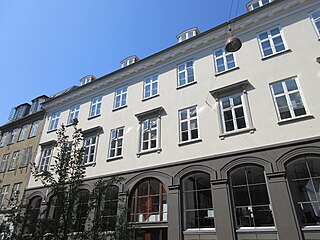
Skindergade 38/Dyrkøb 5 is a four-winged complex of 19th-century buildings with a nine-bays-long facade on Skindergade and a 10-bays-long facade on Dyrkøb, opposite the Church of Our Lady, in the Old Town of Copenhagen, Denmark. The two buildings fronting the streets were listed in the Danish registry of protected buildings and places in 1951. The two side wings—which attach them to each other along each their side of a central courtyard—are not part of the heritage listing. From October 1852 until his death three years later, Søren Kierkegaard was a lodger in the apartment on the first floor. Other notable former residents include the politicians Janus Lauritz Andreas Kolderup-Rosenvinge, Orla Lehmann and Valdemar Rudolph von Raasløff.
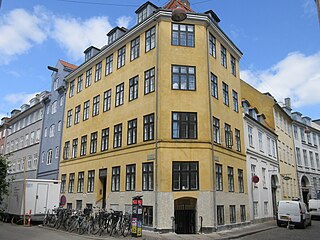
Knabrostræde 25 is an 1830s apartment building situated at the slightly acute-angled corner of Knabrostræde and Snaregade, close to Gammel Strand, in the Old Town of Copenhagen,, Denmark. It was listed in the Danish registry of protected buildings and places in 1945.
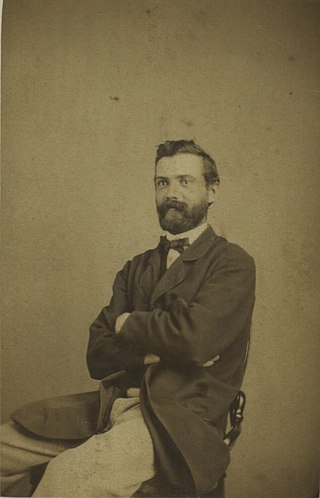
Niels George Steenberg was a Danish engineer who played an important role in the development of Denmark's chemical industry. He was professor of technical chemistry at the Technical University of Denmark from 1894 and president of the Danish Association of Engineers from 1907 to 1910.





















